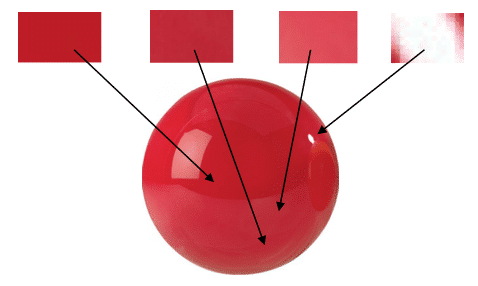True color measurement: What is the difference between the “true” color of an item and its “perceived” color (by the human eye)?
True color measurement vs. perceived color
Just like Distinctness Of Image (DOI) and Reflected Image Quality (RIQ) are better than traditional gloss measurements when you want to assess the perceived “shininess” of a surface [1], there are several ways to measure color. It may come as a surprise to you but color is not an absolute value. We will explain further on the concept of true color and perceived color.
The human brain only works on perceptions with no absolute reference or base line. On top of that, everybody has a very unique sense of color based on the effectiveness of our light receptors (cones). Scientists tried to put numbers on colors (just like they defined time, mass or distance) but how many of us will refer yellow as the 589 nm D line of sodium?
Now comes the tricky part: even if we can define the “true” color of a pure yellow (whatever that is), the same pure yellow, defined with standard LYellow, aYellow, bYellow [2] values as can be measured by ASTM D2244 test, will appear differently depending on the surface condition of the object (texture and gloss).
Just like glossmeters can now measure DOI and RIQ, new generations of spectrophotometers can be set to take into account (or not) the specular component [3] in order to measure, respectively, the true color or the perceived color of an object.
True color measurement
To measure the true color of an item, all the reflected light must be captured, regardless of the reflection angle (specular, scattered or diffuse) [4]: therefore, this type of measurement is called: SCI (Specular Component Included)
Perceived color measurement
To measure the perceived color of an item, the specular component (which is usually the dominant type of reflection) is excluded to make the result more sensitive to scattered light caused by the surface conditions (gloss and texture): therefore, this type of measurement is called: SCE (Specular Component Excluded).
[1] Please refer to our presentation “Beyond Gloss…” for more info on this specific topic
[2] L.a.b. coordinates refers to the color measurements taken in a system called the “L.a.b. sphere” as shown below:
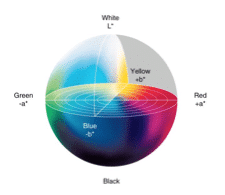
[3] Specular reflection is the perfect reflection (Incoming and outgoing beams have the exact same angle)
[4] “Categories” of reflections :
 Perceived color is affected by the ratio of specular and diffuse reflections
Perceived color is affected by the ratio of specular and diffuse reflections
For the same true color measured, the perceived color may be different, depending on position of the observer (vs. the specular angle of reflection from the light source and its surrounding: reflection from the ground or adjacent objects). The four images below are taken from the same object: a solid red billiard ball
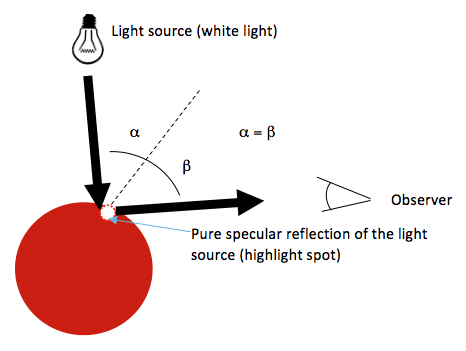 Perceived color is affected by gloss
Perceived color is affected by gloss
Two identical objects with the same true color will be perceived as having a vivid or a dull color depending on the gloss.
High gloss surfaces (i.e.: 70 GU or more) with a high specular component will appear as more saturated in color (vivid).
Semi-glossy surfaces (typically 20-70 GU) will appear less saturated because of the decreasing specular component of the reflected light.
Matt surfaces (20 GU or less) with a low specular component, will appear duller.
What perceived color vs. true color looks like
As a picture is worth a thousand words, let’s see a graphical example of what perceived color vs. true color looks like:
Picture 1
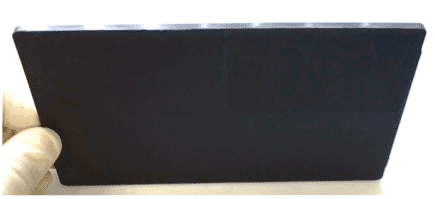 At this angle, there is no specular reflection reaching our eye, we actually see the sample in “SCI mode”, we see the true color. The gloss and texture of the object does not affect our judgement of the color.
At this angle, there is no specular reflection reaching our eye, we actually see the sample in “SCI mode”, we see the true color. The gloss and texture of the object does not affect our judgement of the color.
Picture 2
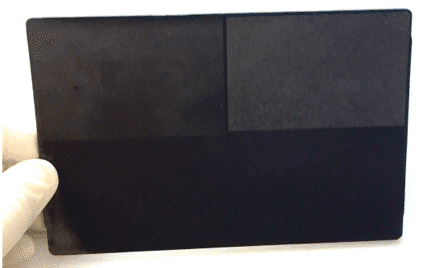 As we rotate the sample towards the light source, the specular component reflected from the glossiest and smoothest surfaces start increasing, therefore our brain now receives different information from the 3 s˜urfaces. We are shifting to SCE mode.
As we rotate the sample towards the light source, the specular component reflected from the glossiest and smoothest surfaces start increasing, therefore our brain now receives different information from the 3 s˜urfaces. We are shifting to SCE mode.
Picture 3
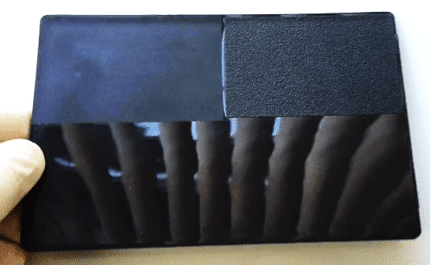 When the sample is put flat on the table, the brain clearly sees 3 different “colors” as the specular component reflected on the glossiest surface makes it appear saturated in color (vivid) when the other two look duller. We now are in pure SCE mode, we cannot tell what the “real” color is. We can only say that they look different. To determine which one is the good one, we need a reference or target “color”. At this point, it all depends on the aesthetic aspect sought after (are you looking for a cozy look or flashy effect?).
When the sample is put flat on the table, the brain clearly sees 3 different “colors” as the specular component reflected on the glossiest surface makes it appear saturated in color (vivid) when the other two look duller. We now are in pure SCE mode, we cannot tell what the “real” color is. We can only say that they look different. To determine which one is the good one, we need a reference or target “color”. At this point, it all depends on the aesthetic aspect sought after (are you looking for a cozy look or flashy effect?).
True color measurement in SCI and SCE modes
The tables below show the measured values in SCI and SCE modes. As anticipated, in SCI mode, all 3 surfaces have the same (true) color with very little differences (a small DE). As all 3 measurements were taken on the same molded sample; one would expect the same color values.
What is interesting is that in SCE mode (perceived color), we can see that the surface condition makes a huge difference in the color readings. We see that the L values (black-white axis) is much higher for the matte samples, which means they look whiter. That is exactly what we “perceive” when the samples are lying on the table (picture 3).
Measurements in SCI mode (true color)

Measurements in SCE mode (perceived color)

True color measurement vs perceived color measurement conclusion
If you need to verify the color of a formulation to ensure the production is consistent (i.e.: quantity of dye added to a base polymer, paint recipe…) and meets your quality standard, true color measurement under the SCI mode should be used.
If you want to measure the appearance of an object (how the color is perceived) or how the same true color will look on various surfaces, the SCE (perceived color) mode should be used istead. SCE measurement is also a very powerful tool that can put numbers on perception. Instead of rejecting a batch of product because it (arguably) does not look good, you can now put numbers and a pass/fail criterion on the perceived color.
Awareness of the difference between SCE and SCI is critical when doing accelerated aging (whether light aging or accelerated corrosion testing) as it provides a more holistic approach as to what will be the end user’s perception. After all, isn’t it all that counts? Insuring end user satisfaction.
The video below shows different surface reflections:
If you have any questions about true color measurement tests, perceived color measurement tests or any other material tests, we invite you to contact us today. It will be our pleasure to answer your questions and review your custom testing requirements.
Download the PDF version of this article below:
The Appendix below provides additional information about numerous material tests carried out at Micom Laboratories including color difference measurement.


